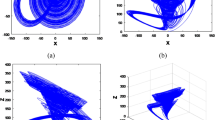Abstract
Recently, chaos based pseudo-random number generator (PRNG) for video encryption was proposed. Security analysis presented in this paper reveals serious problems. Chaotic maps used in analyzed PRNG do not enhance its security due to a considerable number of initial values that lead to fixed points. Also, based on 6 known iterations, an attacker can reconstruct a secret key used in the working stage of the analyzed PRNG based on attack whose complexity is much smaller than the estimated key space. Therefore, security of the analyzed PRNG is much lower than expected and it should be used with caution. Some potential improvements of the analyzed PRNG are proposed which could eliminate perceived shortcomings of the original version.


Similar content being viewed by others
References
Ahmad M, Alam MZ, Ansari S, Lambić D, AlSharari HD (2018) Cryptanalysis of an image encryption algorithm based on PWLCM and inertial delayed neural network. J Intell Fuzzy Syst 34:1323–1332
Akhshani A, Akhavan A, Mobaraki A, Lim S-C, Hassan Z (2014) Pseudo random number generator based on quantum chaotic map. Commun Nonlinear Sci Numer Simulat 19:101–111
Ecrypt II yearly report on algorithms and keysizes. (2010). http://www.ecrypt.eu.org/documents/D.SPA.13.pdf
Francois M, Grosges T, Barchiesi D, Erra R (2013) A new Pseudo-Random number generator based on two chaotic maps. Informatica 24(2):181–197
Francois M, Grosges T, Barchiesi D, Erra R (2014) Pseudo-random number generator based on mixing of three chaotic maps. Commun Nonlinear Sci Numer Simulat 19:887–895
Garcia-Martinez M, Campos-Canton E (2015) Pseudo-random bit generator based on multi-modal maps. Nonlinear Dyn 82:2119–2131
Hellwagner H, Kuschnig R, Stutz T, Uhl A (2009) Efficient in-network adaptation of encrypted h.264/SVC content, Signal Process. Image Commun 24:740–758
Kodikara Arachchi H, Perramon X, Dogan S, Kondoz AM (2009) Adaptation-aware encryption of scalable h.264/AVC video for content security. Signal Process Image Commun 24:468–483
Lambić D (2017) Cryptanalyzing a novel pseudorandom number generator based on pseudorandomly enhanced logistic map. Nonlinear Dyn 89:2255–2257
Lambić D (2018) Security analysis and improvement of the pseudo-random number generator based on quantum chaotic map. Nonlinear Dyn 94:1117–1126
Lambić D (2018) Security analysis of the pseudo-random bit generator based on multi-modal maps. Nonlinear Dyn 91:505– 513
Lambić D, Nikolić M (2017) Pseudo-random number generator based on discrete-space chaotic map. Nonlinear Dyn 90:223–232
Lanford OE III (1998) Some informal remarks on the orbit structure of discrete approximations to chaotic maps. Exp Math 7(4):317–324
Schneier B (1996) Applied cryptography. Wiley, New York
Stojanovski T, Kocarev L (2001) Chaos-based random number generators-part i: analysis. IEEE Trans Circuits Systems I Fund Theory Appl 48:281–288
Stoyanov B, Kordov K (2015) Novel secure pseudo-random number generation scheme based on two tinkerbell maps. Adv Stud Theor Phys 9:411–421
Vaferi E, Sabbaghi-Nadooshan R (2015) A new encryption algorithm for color images based on total chaotic shuffling scheme. Optik 126:2474–2480
Xu H, Tong X, Meng X (2016) An efficient chaos pseudo-random number generator applied to video encryption. Optik 127:9305–9319
Zeng L, Liu R (2015) Cryptanalyzing a novel couple images encryption algorithm based on DNA subsequence operation and chaotic system. Optik 126(24):5022–5025
Zhang Y (2015) Cryptanalysis of a novel image fusion encryption algorithm based on DNA sequence operation and hyper-chaotic system. Optik 126(2):223–229
Author information
Authors and Affiliations
Corresponding author
Ethics declarations
Conflict of interests
The authors declare that they have no conflict of interest.
Additional information
Responsible Editor: S. Bhunia
Rights and permissions
About this article
Cite this article
Lambić, D., Janković, A. & Ahmad, M. Security Analysis of the Efficient Chaos Pseudo-random Number Generator Applied to Video Encryption. J Electron Test 34, 709–715 (2018). https://doi.org/10.1007/s10836-018-5767-0
Received:
Accepted:
Published:
Issue Date:
DOI: https://doi.org/10.1007/s10836-018-5767-0




